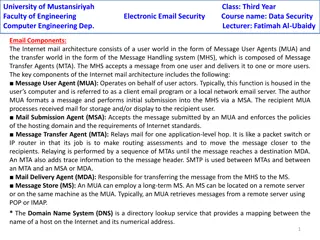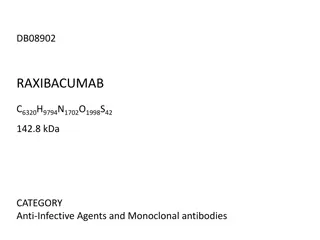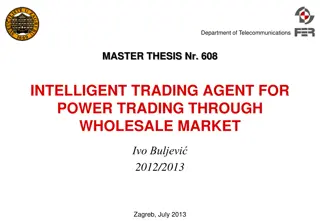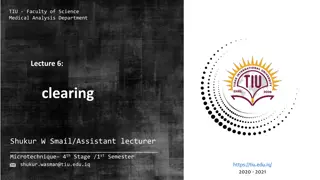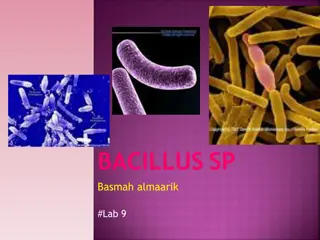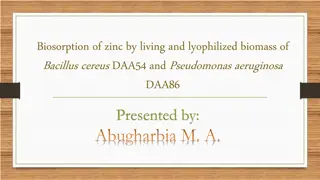Bacillus Anthracis: Causative Agent of Anthrax
Bacillus anthracis, a non-motile aerobic Gram-positive bacterium, is the causative agent of anthrax. It was the first pathogenic bacterium seen under a microscope in 1849, associated with the transmission of contagious diseases via infected blood. This bacterium has notable virulence factors, including the Anthrax capsule and toxin, driving its pathogenesis. Anthrax can be transmitted through various modes, leading to different clinical types in humans, such as cutaneous, pulmonary, and intestinal anthrax.
Download Presentation

Please find below an Image/Link to download the presentation.
The content on the website is provided AS IS for your information and personal use only. It may not be sold, licensed, or shared on other websites without obtaining consent from the author.If you encounter any issues during the download, it is possible that the publisher has removed the file from their server.
You are allowed to download the files provided on this website for personal or commercial use, subject to the condition that they are used lawfully. All files are the property of their respective owners.
The content on the website is provided AS IS for your information and personal use only. It may not be sold, licensed, or shared on other websites without obtaining consent from the author.
E N D
Presentation Transcript
BACILLUS ANTHRACIS Dr. Priyanka Chaturvedi Assistant Professor
BACILLUS ANTHRACIS Causative agent of anthrax. Used as a BIOLOGICAL WEAPON. First bacterium to be isolated in pure culture by Robert Koch and Koch s postulate were made based on B. anthracis. Anthrax vaccine. vaccine was the first live attenuated bacterial
BACILLUS ANTHRACIS It was the first pathogenic bacterium seen under microscope (by Pollender, 1849). It was the first communicable disease shown to be transmitted by inoculation of infected blood.
Introduction Bacillus anthracis causes ANTHRAX It is a non-motile aerobic Gram positive bacteria. Large rectangular capsulated rods arranged in chains with non- bulging spores. Pathogenic species:- 1. B. anthracis 2. B. cereus Bacillus species are generally motile (with peritrichous flagella) and non-capsulated except Bacillus anthracis.
Virulence Factors and Pathogenesis Pathogenesis of anthrax is due to two important virulence factors- Anthrax toxin and Capsule.
Virulence factors A) Anthrax capsule: Made up by polyglutamate It inhibits complement mediated phagocytosis. B) Anthrax toxin: Tripartite toxin with three fragments Edema factor: Increases cAMP and is responsible for edema Protective factor: Helps to bind with host Lethal factor: Causes cell death
Transmission Modes of transmission: Inoculation of spores (most common mode) : Spores enter through the abraded skin. Seen in people with occupational exposure to animals Inhalation of spores Ingestion of carcasses of animals dying of anthrax containing spores (manifested as bloody diarrhea).
Clinical Types There are mainly three types of human anthrax: Cutaneous anthrax 1. Pulmonary anthrax 2. Intestinal anthrax 3.
CUTANEOUS ANTHRAX PULMONARY ANTHRAX Other name Hide porter s disease Wool sorter s disease Transmission Through abraded skin Through aerosols Characterized by Malignant pustule Hemorrhagic anemia Occupational exposure Dock worker ,butcher, farmer Workers of wool factory
CUTANEOUS ANTHRAX PULMONARY ANTHRAX Occurrence Most common Rare Prognosis Rarely fatal Fatal Bioterrorism Not associated with bioterrorism Associated with bioterrorism
LABORATORY DIAGNOSIS Specimen Collection: Pus or swab from malignant pustule Sputum in pulmonary anthrax Gastric aspirate, feces or food (in intestinal anthrax)
LABORATORY DIAGNOSIS Staining : Gram s stain McFadyean's reaction: Capsule appears as amorphous purple material surrounding blue bacilli. Spores : demonstrated by special stain like hot malachite green (Ashby s method) or 0.25% sulphuric acid (spores are acid fast).
LABORATORY DIAGNOSIS Mcfadyean's reaction- amorphous purple capsule surrounding blue bacilli (Polychrome Methylene Blue Stain)
A. Direct smear shows Gram-positive, large rectangular bacilli and pus cells B. Culture smear-Gram positive bacilli (bamboo stick appearance)
LABORATORY DIAGNOSIS Direct immunofluorescence test (direct-IF): detects capsular antigen
CULTURE Bacillus anthracis is aerobic, non-fastidious, grows in ordinary media and has a wide temperature range (12- 450C) of growth. Sporulation is promoted at25-300C and in presence of unfavorable conditions.
CULTURE Nutrient agar: Colonies are 2-3 mm in size, irregular, round, opaque, greyish white with a frosted glass appearance. Medusa head appearance: When colonies are viewed under low power microscope, the edge of colony which is composed of long interlacing chains of bacilli, appears as locks of matted hair.
Medusa head colonies of Bacillus anthracis on nutrient agar ( lOx magnification)
CULTURE Blood agar: Dry wrinkled, non-hemolytic colonies Gelatin stab agar: inverted fir tree appearance (due to liquefaction of gelatin which occurs maximum at surface, and then slows down towards the bottom
CULTURE C. anthracis on blood agar; D. Gelatin stab agar-inverted fir tree appearance Non-hemolytic dry wrinkled colonies of Bacillus
CULTURE Selective media: Solid medium with penicillin: Colonies have a string of pearl appearance look . PLET medium: consists of POLYMYXIN, LYSOZYME, EDTA AND THALLOUS ACETATEadded in heart infusion agar. It has been devised to isolate B. anthracis from mixtures of other spore bearing bacilli.
BIOCHEMICAL REACTIONS Catalase positive Glucose, maltose, sucrose fermented with production of Acid, but no gas Nitrates coverts to nitrites
Serology : ELISA Immunodiffusion in gel method Molecular methods :- PCR
TREATMENT Anthrax can be successfully treated if the disease is promptly recognized and appropriate therapy is initiated early . Antibiotic Clindamycin for 60 days regimen Ciprofloxacin or Doxycycline, plus
TREATMENT Antibiotics for postexposure prophylaxis: Raxibacumab: It is a monoclonal antibody that neutralizes anthrax toxin (protective antigen). It is intended for the prophylaxis and treatment of inhalational anthrax.
Prevention Disposal of animal carcasses by burning or by deep burial in lime pits. Decontamination ( usually by autoclaving) of animal products. Protective clothing and gloves for handling potentially infectious materials. Live Attenuated, Non-capsulated Spore Vaccine (Stern Vaccine): It is extensively used in animals Alum Precipitated Toxoid Vaccine.






